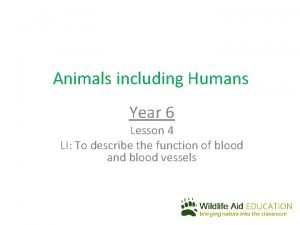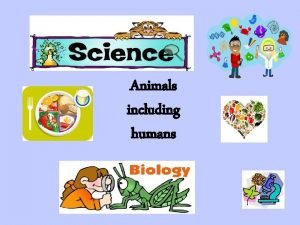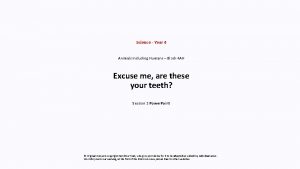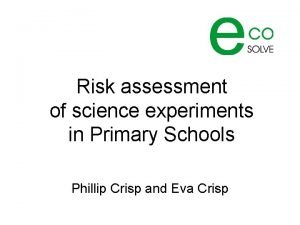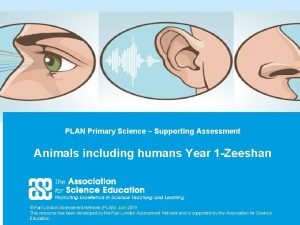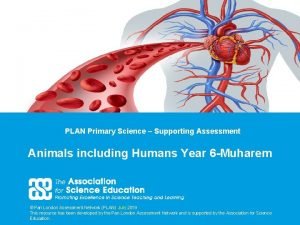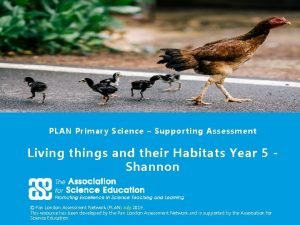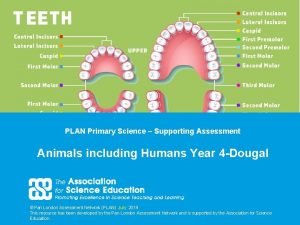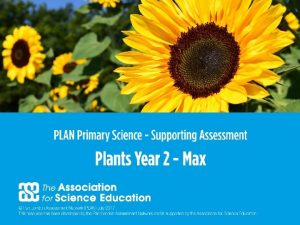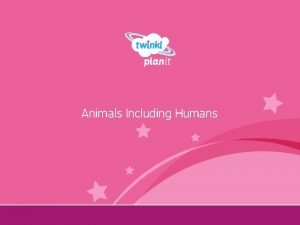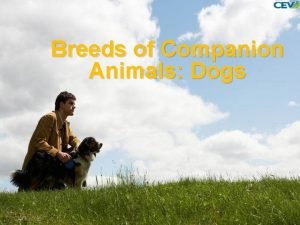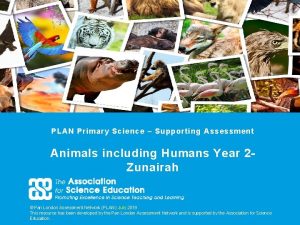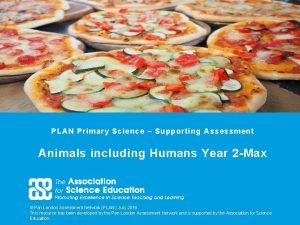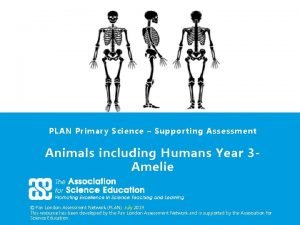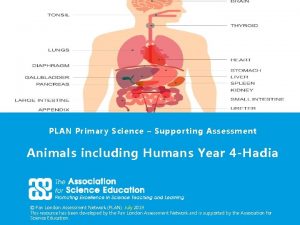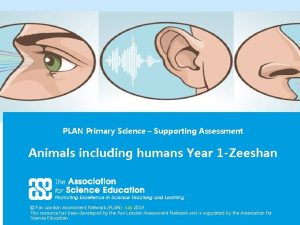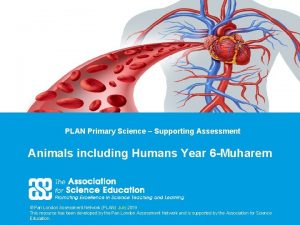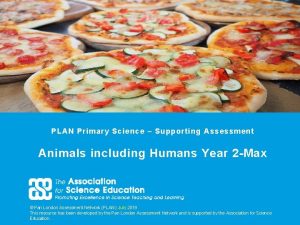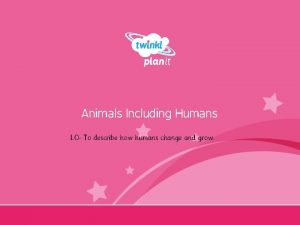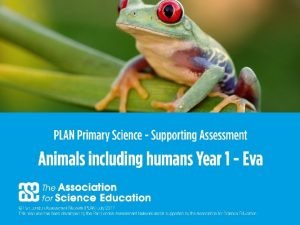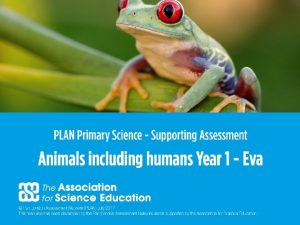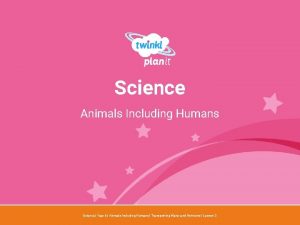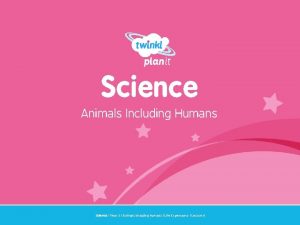PLAN Primary Science Supporting Assessment Animals including humans


















- Slides: 18

PLAN Primary Science – Supporting Assessment Animals including humans Year 1 -Zeeshan © Pan London Assessment Network (PLAN) July 2019 This resource has been developed by the Pan London Assessment Network and is supported by the Association for Science Education. 1

PLAN Primary Science - Supporting Assessment PLAN Primary Science is a set of resources produced to enable teachers to have a clearer understanding of National Curriculum expectations for meeting the standard. Annotated collections of children’s work provide examples of what working at the expected standard for primary science might look like for the knowledge and conceptual understanding statements of the programmes of study (POS). It is not the intention of these resources to specifically exemplify the working scientifically statements. However, aspects of working scientifically have been shown as an integral part of the teaching and learning of the knowledge and concepts. The resources provided have been cross moderated multiple times before publishing so that they can be used with confidence by teachers and subject leaders. Each collection of work shows one example of how a pupil has met National Curriculum statements for a particular area of content but these are not intended to be the definitive way of teaching these statements. 2

Structure of the resources Each resource contains the relevant National Curriculum statements for the unit of work and prior learning, a planning matrix, annotated work and a summary sheet. The matrix provides an interpretation of the key learning of the National Curriculum statements, and suggestions of key vocabulary. In order to be meet the expectations pupils must firstly understand the key concept and then be provided with opportunities to apply that knowledge. This is a key planning tool. Key Learning Secure Possible Evidence Show understanding Overview paragraph describing of a concept by curriculum using scientific vocabulary correctly Key vocabulary – list of words Possible ways to demonstrate key learning, particularly correct usage of vocabulary Apply knowledge in Suggestions of contexts to use. familiar related contexts across a range of enquiry types Possible ways to demonstrate that a pupil has gone beyond recall of facts and can apply the key learning, for example using the vocabulary and basic principles to produce explanations, usually within Working Scientifically contexts. 3

Contents of the materials Please note: The NC statements for each topic area for the relevant year group are stated on the slide. Only the statements in bold on that slide have been exemplified. In these cases the teachers have chosen to split the statements within the topic area to teach at different times. The prior NC statements relevant to the topic area are also stated and use to determine pupils’ knowledge at the start of the unit. Each slide has been annotated with coloured text. Please see key below: Red statements Blue Commentary to explain how evidence meets/does not meet NC Commentary to highlight features of working scientifically Green Pupil Speak Grey Other relevant information eg. vocabulary used 4

Y 1 Statements Pupils should be taught to: • identify and name a variety of common animals including fish, amphibians, reptiles, mammals and birds (1 -Animals including Humans) • identify and name a variety of common animals that are carnivores, herbivores and omnivores (1 -Animals including Humans) • describe and compare the structure of a variety of common animals (birds, fish, amphibians, reptiles, and mammals, including pets) (1 Animals including Humans) • identify, name, draw and label the basic parts of the human body and say which part of the body is associated with each sense. (1 Animals including Humans) 5

Later Statements Pupils do not need to be taught content they will learn in later year groups. They can be challenged by applying the content for their year group in broader contexts. In Year 2 pupils will be taught to: • describe how animals obtain their food from plants and other animals, using the idea of a simple food chain, and identify and name different sources of food. (2 -Animals including Humans) In Year 6 pupils will be taught to: • describe how living things are classified into broad groups according to common observable characteristics and based on similarities and differences, including micro-organisms, plants and animals (6 -Living things and their Habitats) • give reasons for classifying plants and animals based on specific characteristics. (6 -Living things and their Habitats)

Key learning Possible Evidence Shows understanding of a concept using scientific vocabulary correctly Animals vary in many ways having different structures e. g. wings, tails, ears etc. They also have different skin coverings e. g. scales, feathers, hair. These key features can be used to identify them. Animals eat certain things - some eat other animals, some eat plants, some eat both plants and animals. Key vocabulary Head, body, eyes, ears, mouth, teeth, leg, tail, wing, claw, fin, scales, feathers, fur, beak, paws, hooves Names of animals experienced first-hand from each vertebrate group N. B. The children need to be able to name and identify a range of animals in each group e. g. name specific birds and fish. They do not need to use the terms mammal, reptiles etc. or know the key characteristics of each, although they will probably be able to identify birds and fish, based on their characteristics. The children also do not need to use the words carnivore, herbivore and omnivore. If they do, ensure that they understand that carnivores eat other animals not just meat. Can name a range of animals which includes animals from each of the vertebrate groups Can describe the key features of these named animals Can label key features on a picture/diagram Can write descriptively about an animal Can write a What am I? riddle about an animal Can describe what a range of animals eat Applying knowledge in familiar related contexts, including a range of enquiries Make first hand close observations of animals from each of the groups Compare two animals from the same or different group Classify animals using a range of features Identify animals by matching them to named images Classify animals according to what they eat Can sort and group animals using similarities and differences Can use simple charts etc. to identify unknown animals Can create a drawing of an imaginary animal labelling its key features Can use secondary resources to find out what animals eat, including talking to experts e. g. pet owners, zoo keepers etc. SECURE Assessment guidance

Investigating and naming body parts • identify, name, draw and label the basic parts of the human body and say which part of the body is associated with each sense This unit of learning started with familiarising the pupils with the names of the main body parts, through songs and rhymes. They went on to draw around their partners and label the body parts. Images from the class floor book capture a range of pupils learning. The teacher records that all pupils were successful in this core learning; Zeeshan was able to name, draw and label core body parts. Zeeshan was able to use non-standard units to measure how tall his partner was. 8

Investigating different heights of pupils in the class • identify, name, draw and label the basic parts of the human body and say which part of the body is associated with each sense The class floor book captures a range of pupil heights from the measuring activity. Zeeshan records that his partner is 5 blocks tall. He was able to use non-standard measures. The class then discussed comparative heights using language of comparison – taller, shorter. Adil is 5 blocks tall and I am 6. I am taller than him 9

Investigating different senses • identify, name, draw and label the basic parts of the human body and say which part of the body is associated with each sense The pupils engaged in an afternoon of senses activities, which included feely bag activities, a ’looking & listening’ sensory walk outside, a taste test and a ‘smelly pot’ identification test. Pupils quotes were captured by the adults accompanying the walk. I heard a police siren, builders banging and children talking. I used my ears to hear. Zeeshan understands how his 5 senses use different parts of the body and orally explained which part related to which sense. 10

Linking senses to body parts • identify, name, draw and label the basic parts of the human body and say which part of the body is associated with each sense Zeeshan also independently drew and labelled a picture of himself and labelled the senses he associates with each part. Zeeshan annotated the body part picture of his partner with senses labels to show this link. 11

Exploring animals and their groups, including their diets • identify and name a variety of common animals including fish, amphibians, reptiles, mammals and birds identify and name a variety of common animals that are carnivores, herbivores and omnivores The class watched a video on animal life and classification, where they were introduced for the first time to the terminology of the main animal groups. As a class they then used a sorting grid provided and discussed and sorted the animals they’d seen from the video clip into the different groups. Zeeshan names animals which were birds, mammals and insects. At this early stage he needed help identifying animals which were reptiles and animals which were amphibians. He could name a good range of common animals which he already knew and a few others from the class work. 12

Exploring animals and their groups, including their diets • identify and name a variety of common animals including fish, amphibians, reptiles, mammals and birds identify and name a variety of common animals that are carnivores, herbivores and omnivores The class are regular visitors to Stepney City Farm. In this visit they focused on being able to identify a range of different animals and learn about what they eat. Foxes are omnivores. They eat meat and vegetables. Foxes are mammals. Zeeshan names a variety of common farm animals and what they eat; he also identifies some animals from the farm visit which are omnivores, carnivores and herbivores. 13

Sorting and grouping common animals • describe and compare the structure of a variety of common animals (birds, fish, amphibians, reptiles, and mammals, including pets) Pupils named and described the features of and subsequently sorted a variety of common animals, including reptiles and amphibians. Zeeshan and his group used some given sorting criteria and others which they chose themselves. They labelled their groups. They noticed that not all groups had the same number of animals in them. I liked sorting by tail and no tail. The hedgehog had no tail. He was the only one. During this activity Zeeshan named the snake, crocodile and frog and talked about their features. Zeeshan securely describes and compares the structure of animals within all five vertebrate groups. 14

Comparing animals • describe and compare the structure of a variety of common animals (birds, fish, amphibians, reptiles, and mammals, including pets) Following on from the sorting and grouping activity, pupils were asked to choose 2 animals and independently record the differences and similarities in the structure of the 2 animals. Zeeshan identifies different body parts. He correctly records that only the horse has hooves. He identifies that both animals have tails. Work from another child for comparison 15

Describing the school pet • describe and compare the structure of a variety of common animals (birds, fish, amphibians, reptiles, mammals and invertebrates, and including pets) In a final piece of work for the unit, the class applied what they had learnt about different body parts of animals to the school dog, Coco eats dog meat. She is a carnivore. Zeeshan identifies different body parts, such as paws, tail, nose and ears and knows what Coco eats. Zeeshan consistently names a good range of vertebrate animals and describes and compares their structure. 16

Overall Summary Overall summary – secure Whilst much of the evidence for pupils science learning is kept in floor books, the adults also capture quotes and discuss learning with pupils in order to gauge learning at any point in time. The range of evidence and quotes captured, alongside adult knowledge of pupils shows that Zeeshan is secure in his learning for this unit. Evidence shows that Zeeshan names a range of animals which includes animals from each of the vertebrate groups, from videos and from farm visits. He describes the key features of these named animals and labels key features on a picture/diagram. After thinking about the school dog he writes descriptively about an animal. Through the farm visit and in class work, he describes what a range of animals eat, particularly animals which interest him like foxes. Throughout the unit he has had a number of opportunities to sort and group animals using similarities and differences, including by features of the animals, by animal groupings and by diet. In the farm visit he was able to use secondary resources to find out what animals eat, by asking questions of the farm staff. 17

Acknowledgements 18
 Animals including humans year 6
Animals including humans year 6 Animals including humans clipart
Animals including humans clipart Animals including humans year 4
Animals including humans year 4 Science risk assessment primary school
Science risk assessment primary school Plan primary science
Plan primary science Plan primary science
Plan primary science Plan primary science
Plan primary science Digestive parts
Digestive parts Plan primary science
Plan primary science What is your favorite subject and why science
What is your favorite subject and why science Kyle douglass
Kyle douglass Are bears producers or consumers
Are bears producers or consumers Parasitic food chain
Parasitic food chain Carnivore
Carnivore Primary and supporting instruments
Primary and supporting instruments Attitude + power = performance
Attitude + power = performance Food energy diagram
Food energy diagram Primary consumer animals
Primary consumer animals Which of the following is not indicative of most beagles?
Which of the following is not indicative of most beagles?
